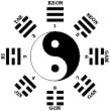About the Chinese medical and philosophical concepts of yin and yang. How it works and is applied to Chinese medical understanding.
The concept of Yin and Yang
In Chinese medical theory the concept is that Qi circulates around the body along specific channel pathways which have relationships and connections to the organs they share their names with. Life is a result of the interaction of yin and yang. Medicine requires action to restore the balance of the body.
The Chinese word Qi also means, air and breath, thus intimately associated with life, like the concept of prana in yoga and ayurvedic theory. Qi can be understood as a description of physiological processes or function, as a dynamic. In many ways it makes more sense to think about it like this than simply as a substance. Yin and Yang are relative states of the Qi, always dynamically interracting, intertransforming and generating each other.
Yin is the more passive, still, solid, cold; yang is the more active, moving, rarified, hot. One way I like to explain their relativity is using the analogy of different states of water. Ice is more yin than water, so water is therefore more yang than ice, but steam is more yang than water, so in that relationship water is yin.
The Tai Ji
 The concept of yin and yang is often misunderstood and poorly translated. It is summed up in the symbol of the Taiji, translated as ‘supreme ultimate’ or ‘great polarity’. It represents all things, and is the same word as Tai Chi as in Tai Chi Chuan, the martial art and health promoting exercise.Each property is interrelated, they are interdependent, mutually consuming and in opposition. Each contains a little of the other, the potential of their opposite, existing in a state of dynamic equilibrium.
The concept of yin and yang is often misunderstood and poorly translated. It is summed up in the symbol of the Taiji, translated as ‘supreme ultimate’ or ‘great polarity’. It represents all things, and is the same word as Tai Chi as in Tai Chi Chuan, the martial art and health promoting exercise.Each property is interrelated, they are interdependent, mutually consuming and in opposition. Each contains a little of the other, the potential of their opposite, existing in a state of dynamic equilibrium.
Something can only be considered either yin or yang in relation to something else. For example ice would be yin to water as it is less active, solid, cold, but water would be yin comparred with steam which is more ‘active’, hot, fast moving and dynamic and therefore yang.
Taoism
Taoism has both philosophical and devotional religious branches. The core ideas are laid out in the Tao Te Jing, a famous book of Chinese wisdom and then Zhuang Zi, a book of fables and anecdotes making points about the meaning of life.
Taoism (also transliterated as Daoism) was very influential in the development of early Chinese medicine and acupuncture, especially in the Tang Dynasty ~600-900AD. Religious Daoism contains a lot of longevity practices, meditation, Daoyin, exercises and herbs which played a role in the development of much Chinese medical theory.
Confucian concepts and Buddhism also played a considerable role in different areas of Chinese medicine development. It is important to realise that religion in traditional China was much less sectarian than we are used to in the West. An individual might be confucian in their family, a buddhist when married and a daoist to venerate their ancestors.








